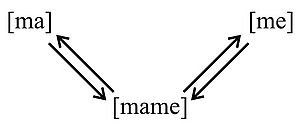Quantum Approaches to Consciousness
The Stanford Encyclopedia of Philosophy surveyed some popular approaches for applying quantum theory to consciousness. Variants of the dichotomy between mind and matter range from their fundamental distinction at a primordial level of description to the emergence of mind (consciousness) from the brain as an extremely sophisticated and highly developed material system.
According to the Stanford group, in most approaches material (ma) brain states are considered to be directly related to mental (me) states of consciousness, the direct way (A),
(A) 
This point of view claims that it is both necessary and sufficient to explore and understand the material domain, e.g., the brain, in order to understand the mental domain, e.g., cognition and consciousness.
"The most discussed counterarguments emphasize the impossibility for material accounts to properly incorporate the quality of the subjective experience of a mental state. Nagel asked "what it is like" to be in that state. This leads to a gap between third-person and first-person accounts for which David Chalmers has coined the notion of the hard problem of consciousness."
"As an alternative to (A), it is possible to conceive mind-matter relations indirectly (B):
(B) 
Here denoted [mame], is often regarded as being neutral with respect to the distinction between [ma] and [me], i.e., psychophysically neutral." Scenario (B) depicts the "dual aspect" option of reality.
Following the Stanford approach, I will now briefly review the major theories of quantum consciousness.
 Dr. N.L. Kachhara
Dr. N.L. Kachhara
